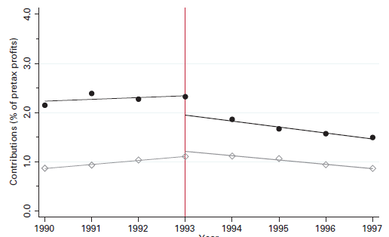 In the ideal world, we would like firms to make a profit and also to help the environment and society. Indeed, the turn toward ESG (environment, social, and governance) evaluation of firms is evidence that this is important to many, including a growing niche of investors who favor firms that are responsible as well as profitable. Are we living in this ideal world already? Or if not, are we moving toward it? The answers are not clear. In a recent article in Administrative Science Quarterly, Ben W. Lewis and W. Chad Carlos looked at how firms reacted to being rated as charitable. Being rated as charitable is supposed to be good, both because it means that they contribute to the social dimension (the S of ESG) and also, indirectly, that they are profitable enough that they can afford to do so. Many firms cannot. If we lived in the ideal world combining profits and ESG, or even a more limited world combining profits and social contribution, managers would savor such a rating and continue making philanthropic contributions. But in fact, firms rated as charitable reduced their philanthropic contributions. How can this be? To begin with, we can dismiss the idea that firms don’t care about ratings, because there is much evidence that they care and that they try to get high rating outcomes even it is costly to do so. If high ratings matter and executives decide to avoid a high rating outcome, something else is at work. The explanation has two parts: competing logics and reactivity. Competing logics exist when firms are rated – or more broadly, evaluated – on multiple criteria, and these are backed by different groups with conflicting interests. For firms, the main group that executives worry about are shareholders, of course, and their interest in maintaining steady profits and investments in gaining future profits. The logic in this is how firms can accomplish the valuation increases and dividends shareholders crave. Through this logic, money given away to philanthropic contributions is just like money invested to protect the environment that does not also increase productivity. It not only reduces current valuation increases but may also hold back investments that would help future valuation increases. From the shareholders’ point of view, this is bad even if the ability to fund charity signals current profits. What about reactivity? This part is easy to explain. Executives have many reasons to make philanthropic contributions, including the obvious one that they personally want to make societal contributions using firm resources. But executives also know that they are monitored by shareholders and financial analysts. If their contributions are so high that they are labeled as “nice” by a ratings agency, they may be targeted as acting contrary to shareholder interests. It is much better to make contributions that are small enough to be below the radar, so they react by reducing contributions. It may seem like a reverse form of impression management that executives try to avoid a high rating of the firm, but it simply reveals that the most important audience for impression management is shareholders. How big and important were these effects? Quite big. The ratings agency studied was KLD, which is a major rater of firm social contributions. Following a positive rating, firms reduced their philanthropic contributions by about one-half of a percent of profits, which is one-third of the average difference between firms rated positively and firms not given a positive rating by KLD. Simply put, the firms reduced contributions exactly as much as needed to become rated as less charitable the next year. We know that firm decision makers care about their reputation, engage in impression management, and pay attention to ratings. To observe reactivity like this is a clear signal that we do not yet live in an ideal world in which firms can divide attention between profits and ESG criteria, and we do not even know whether we are moving in that direction. Time will tell. Lewis, Ben W., W. Chad Carlos. Avoiding the Appearance of Virtue: Reactivity to Corporate Social Responsibility Ratings in an Era of Shareholder Primacy. Administrative Science Quarterly, forthcoming. Comments are closed.
|
Blog's objectiveThis blog is devoted to discussions of how events in the news illustrate organizational research and can be explained by organizational theory. It is only updated when I have time to spare. Archives
May 2024
Categories |
 RSS Feed
RSS Feed